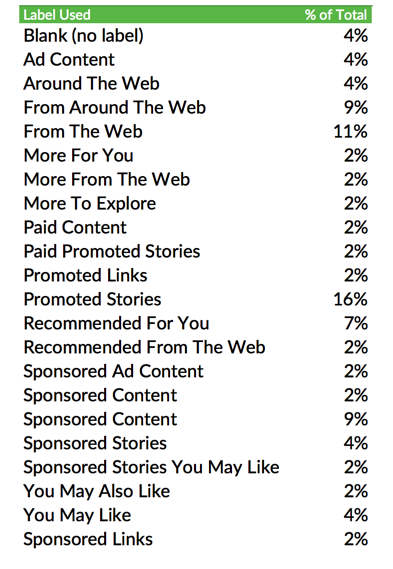
“Promoted stories” have taken over the web. The widgets, which hawk dubious dietary supplements and a wide variety of clickbait, have become an unfortunate staple of websites — both news-focused and otherwise — thanks largely to the ad rates they pay publishers, which tend to be higher than standard banner ads. They are, to many, a necessary evil for publishers desperate for more revenue from wherever they can get it.
But a new report shows that, while the widgets may be good for publishers’ bottom lines, they’re bad for publishers’ relationships with readers. ChangeAdvertising.org, a nonprofit focused on data and web ads, looked at the top 50 news sites for two days last month to get a sense of what their widgets looked like, and what users were likely to find when they clicked the stories those widgets promoted. Here are a few of its findings:
Only half of the 312 links in recommended content widgets actually went to what it considered legit advertisers. In contrast, a quarter of the remaining links went to clickbait sites, and 15 percent linked to real content from other legitimate sites. Four percent of links went to fake news.
Clickbait links are often bait-and-switch. This might not be a surprise to anyone who has ever clicked a recommended content link, but recommended content headlines are often very different from those for the stories the link to. Clicking “Horrifying Woodstock Photos That Were Classified” sends you to a story titled “Rare Photos From Woodstock,” to use one example of 20 that ChangeAdvertising.org cites.
Recommended content widgets still have a disclosure problem. As with publishers, the recommended content companies can’t quite settle on the best way to disclose that their content is paid for. The preferred label, “Promoted Stories,” appeared on 16 percent of the links Change Advertising looked it. At 11 percent, “From the Web” came second, followed by “From Around The Web” (9 percent) and “Recommended for You” (7 percent). The most clear labels (“Paid content,” “Ad content,” etc.) were the least used.
 Nearly all (89 percent) of the clickbait sites that buy recommended content ads are registered anonymously. This is far higher than the equivalent rates of news sites and legitimate advertisers (11.5 percent and 26 percent, respectively) disguising their domain information from public registry sites.
Nearly all (89 percent) of the clickbait sites that buy recommended content ads are registered anonymously. This is far higher than the equivalent rates of news sites and legitimate advertisers (11.5 percent and 26 percent, respectively) disguising their domain information from public registry sites.
“This seems to be about figuring out where all this (substantial amount of) money might be flowing, and it appears to be very opaque to me and some other industry observers,” said Rob Leathern, founder of Change Advertising and CEO of Optimal.com. (Conflict-of-interest alert: Optimal also makes adblocking software and a payments-in-lieu-of-ads tool, so emphasizing the rottenness of online advertising is in its interests.) “One senior person at one of the big internet companies told me ‘publishers hate these companies but make too much money from them to stop working with them.’ That seems worth digging into more.”